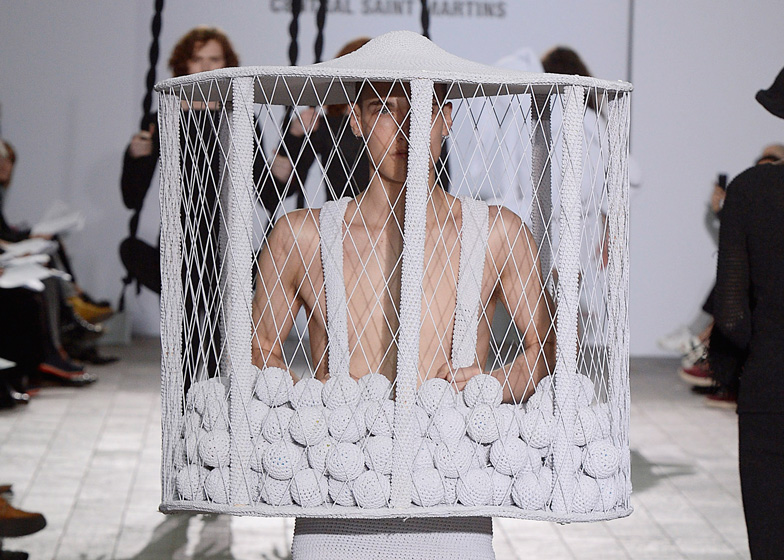Graduate shows 2015: Dezeen's Dan Howarth selects his favourite collections from the 2015 crop of Central Saint Martins BA Fashion graduates, which included wire mobiles, knitted puppets and balloon animals.
Forty students from this year's batch of graduates presented their work during a show at Central Saint Martins' Kings Cross campus last Wednesday, while the remaining students staged a protest outside the venue.
Course director Willie Walters told Dezeen that the show was "a digestible selection of work which best represents the stories, themes and techniques of the BA course".
Like the BA Fashion graduates from the Royal College of Art, who showed their collections on the same evening last week, many of the Central Saint Martins students turned their garments into wearable sculptures with the use of wire frames, inflatables and structured fabric elements.
Read on for Dezeen's top six collections from this year's show:
Gabriele Skucas
Gabriele Skucas knitted his entire menswear collection from black and white wool, creating both wearable garments and a collection of absurd "accessories" shaped like children's toys.
These included dolls strung in a chain around the neck, a giant rabbit carried on the back, and a set of swimming aids such as a snorkel, arm bands and a ring.
A pair of swings were attached to the rears of two models, while another wore a ball pit cage that covered his head and surrounded his torso.
The childhood references were paired with slim-fitting T-shirts, shorts and trousers, all loosely knitted and worn with oversized slippers made using the same technique.
Susan Fang
The mobiles of 20th-century American sculptor Alexander Calder were replicated as adornments and accessories by Susan Fang. Tendrils of chiffon jersey and acrylic shapes were suspended away from the body with wires, creating balanced bouncy structures worn around the head, neck or waist.
"The floating wire tendrils are light enough to orbit around the body yet strong enough to hold the linked garment attached to the wire point," Fang told Dezeen.
She used a neutral colour scheme with accents of red, yellow and blue revealed beneath laser-cut fabric – again referencing Calder's selective palette.
"I was inspired by how Calder restricted his colours in his work as he felt colour had different weights, and mainly used black, white, primary colours or middle colours to play with the observer's sense of movement," Fang said.
Han Kim
Sparkling metallic prints were used across Han Kim's fantastical garments, which were paired with lace rabbit ears as a take on Alice in Wonderland-style hallucinations.
"I prefer to use classic embroideries and patterns, so I wanted to distort this into my own style," Kim said.
Using his experience of working on London's Saville Row, the designer tailored and embroidered the garments that included an oval coat and a giant star-shaped jacket.
"Although I'm designing womenswear, I'm keen on the bespoke tailoring of suits," Kim said. "I've tried to use a classic approach to make my own style at the same time."
Jim (Chen-Hsiang) Hu
Using a bespoke loom, Jim Hu wove linen threads into 3D structures that he shaped to embellish a collection of red dresses.
"The 3D woven technique – which I named Xi (系) – was developed through the searching of a proper vocabulary that tells the story," he said. "I was thinking that a single thread or fibre could be understood as the most fundamental part of a garment."
"Normally they are woven two dimensionally, which forms a piece of fabric, and then assembled into a piece or garment," he continued. "What I did was add another dimension/variable."
These were accompanied by two-dimensional grid patterns around the hems of the garments, created with a laser cutter. "It wasn't an easy thing to arrange the flow of grids and the shape of the pattern at the same time," Hu admitted.
James Mitchell
James Mitchell took industrial fishermen's workwear as the starting point for his collection, which mimicked the shapes of overalls and protective gear in softer, lighter fabrics.
"From the start of the year I knew I wanted to use chiffon in contrast to the heavy oil skins worn by trawlermen – expressing an almost romantic notion to the brutality of the job," he told Dezeen.
Retaining the navy and white colour scheme associated with nautical attire, Mitchell also used rib jersey for thermal wear and crinoline for hats – creating layers of garments and accessories rather than "looks" so the pieces can be worn separately.
"I wanted to maintain a utility feel and masculinity via garment construction," he said. "Using flat-lock machines on all of my thermal pieces and French seams on the chiffon created a clean finish."
Angus Lai
Balloon animals covered the back of one of Angus Lai's brightly coloured outfits, which were digitally printed to represent the artificial colouring of processed fast food, and designed as a metaphor for "gluttony and overindulgence".
"I researched into different graphic illustrations of fast food and the different portrayals of character in fast food," Lai said. "I developed the print and silhouette ideas from my own point of view of what food has done to my own self, my mental and physical body, and how my body is affecting my social life, etc."
Faces could be seen in a couple of the outfits, which featured horizontal strips of pattern and quilting to resemble burgers – an idea that was also manifested as stacked hats.
"I just wanted to do something fun, experimental and not so wearable as this might be the last chance to create something that represents myself," he told Dezeen.

